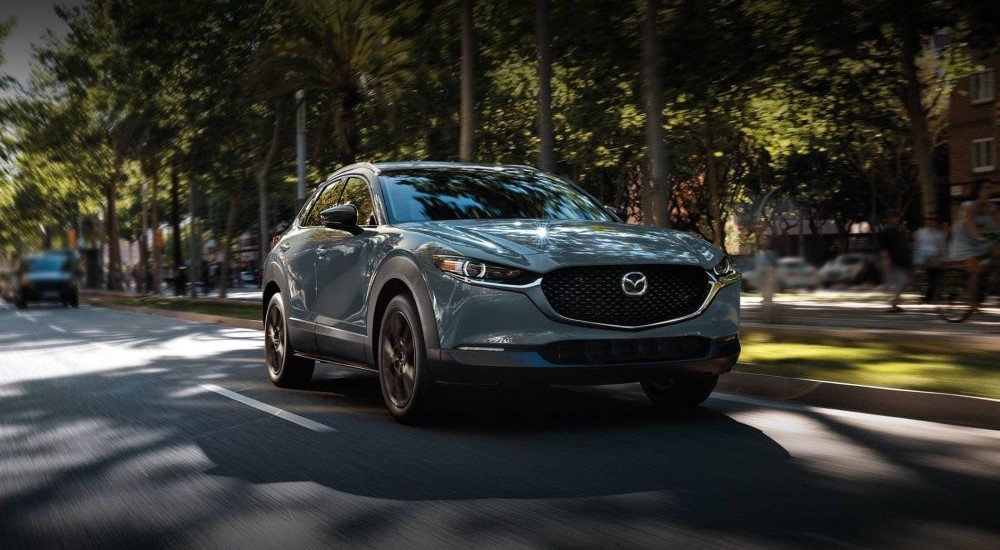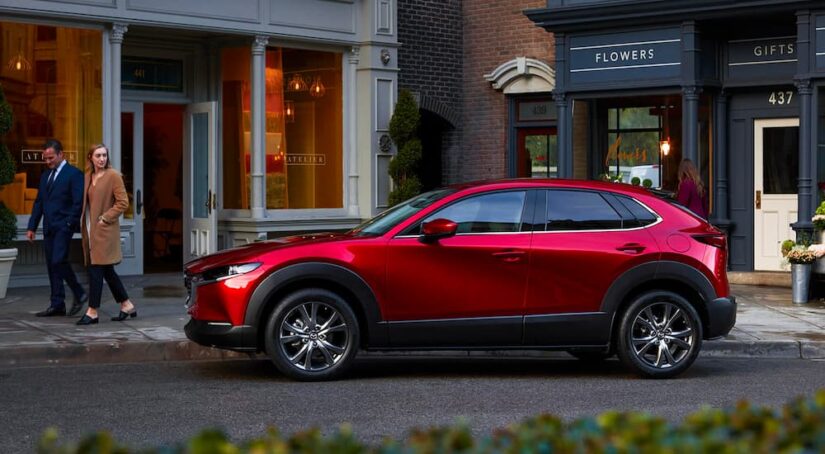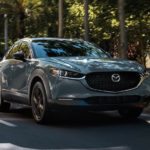If you were a millionaire, what kind of vehicle would you want to drive? Whatever it is you thought of, I’m sure it costs over $25,000. Mind you, $25,000 is not a small amount of money to many drivers, but in my opinion, I’m a strong advocate for innovation via limitations, so I’m drawn to look into what automotive manufacturers can offer drivers more on the cost-conscious side of things. One manufacturer that I feel encapsulates this thought process better than most is Mazda. Your local Mazda dealer can get you behind the wheel of any of the latest Mazda vehicles, but today, I want us to discuss what you can expect if you’re a shopper hoping to spend no more than $25,000 on a brand-new vehicle.
Will you be sorry you didn’t spend a few thousand dollars extra? I’ll get to all that, but first, you should know the three Mazda vehicles I’ll be looking at today: the Mazda CX-30 and both variants of the Mazda3: the sedan and hatchback. That’s one SUV, one sedan, and one hatchback, so unless you’re looking for a van or pickup truck, there’s a Mazda vehicle for you. From pricing to performance and more, the Mazda3 models and CX-30 have much in common, but there’s still an argument to be made for each vehicle.

Two Engine Options for Three Models
There’s a choice between three Mazda vehicles priced under $25,000, and within that option of three, you also have two powertrains available for each one. To set the stage, it’s worth knowing the prices of all three. The 2023 CX-30 starts at $22,950, and the Mazda3 Sedan and Hatchback have starting prices of $22,550 and $23,550, respectively. The price difference between the base CX-30 and base-level Mazda3 Sedan is only separated by a little over a few hundred dollars; I’ll get to the differences between the two momentarily. As for the similarities, both Mazda3 models and the CX-30 come with a 2.5L I-4 engine paired with a 6-speed automatic transmission. What’s identical between the three is the 191 hp and 186 lb-ft of torque.
Horsepower and torque output may be similar between the three vehicles, but it’s the Mazda3 sedan that’s more fuel-efficient. This shouldn’t come as a surprise given that all three cars use the same engine but differ in size; the Mazda3 sedan is the smallest and the most efficient, by extension. The 2023 Mazda3 sedan gets EPA-estimated ratings of 28 MPG in the city and 37 MPG on the highway, while the Hatchback gets 27 MPG in the city and 35 highway, and the CX-30 has 26 MPG in the city and 33 MPG on the highway. The CX-30 has a reason for its lower ratings: the CX-30 comes standard with AWD instead of FWD, which is optional on the Mazda3 vehicles. Aside from that, the Mazda3 Hatchback has something the other two don’t: an optional 6-speed manual transmission. Drivers looking for manual transmissions; well, there’s your answer. Also, the manual transmission doesn’t detract from your fuel efficiency.
The situation is practically mirrored with the optional alternative powertrain. The upgraded powertrain is a turbocharged 2.5L I-4 engine that outputs 250 hp and 320 lb-ft of torque. If we look at these numbers differently: the turbocharged 2.5L I-4 engine has 31% more horsepower than the non-turbocharged 2.5L I-4 and a 72% greater torque output. However, there’s no manually-adjustable transmission for the Mazda3 Hatchback like there is with the standard engine, and fuel efficiency is more similar across the board as a result of standard AWD.
With the turbocharged engine, the Mazda3 Sedan gets EPA-estimated ratings of 23 MPG in the city and 32 MPG on the highway, the Mazda3 Hatchback has 23 MPG in the city and 31 MPG on the highway, and the CX-30 gets similar ratings of 22 MPG in the city and 30 MPG on the highway. Of course, getting the turbocharged I-4 engine can put you over that $25,000 mark, but it’s worth considering if your budget has any wiggle room. As for what you can get for under $25,000, the 2.5L I-4 engine performs well and has excellent fuel efficiency.

Signature Designed Tech
Something aside from performance that establishes that all three vehicles are cut from the same cloth is the array of tech each model offers. Purchasing any of the three vehicles gets you an 8.8-inch infotainment center, which remains the only option between the three. So, from the base model to the highest-end trims, the infotainment experience is identical. These Mazda vehicles can also be fitted with a 4G LTE Wi-Fi hotspot, and all three come standard with Apple CarPlay and Android Auto connectivity.
One of the largest draws to how modern Mazda vehicles are is the MyMazda App, which gives you a more in-depth report on your vehicle’s status and health in an easy-to-comprehend interface on your smartphone, meaning you’ll never be far from the information and features you may need in a moment’s notice like remote start and emergency services. This doesn’t need much explaining, but features like these are appreciated for new vehicles priced under $25,000.
The Real Decision Maker
I’ve gone on about how much the CX-30 and Mazda3 vehicles are alike, but now it’s time to discuss how each car differs. The ultimate difference between the three vehicles is size and cargo space, but there’s no right or wrong answer; you should only purchase the vehicle that provides enough space for what you’ll commonly need. Let’s start with the sedan, which is the easiest on your wallet when buying and owning, thanks to its lowest starting price between the three and the best efficiency. The main detractor between the Mazda3 sedan and the other two vehicles is its cargo space, but I think this doesn’t surprise anyone. For commuters who need their trunk for the occasional cargo, the Mazda3 sedan does great with 13.2 cu.ft. of space.
The Mazda3 Hatchback may not be as large as the CX-30, but it does increase the cargo space available at all times by keeping every seat upright by 52%. This means the Mazda3 Hatchback will always have 20.1 cu.ft. of space, and thanks to its similar fuel efficiency to the sedan, the Mazda3 Hatchback is also an excellent commuter, with the advantage of extra cargo space. Unlike some other SUVs I’ve seen in the past, the CX-30 also lends itself well to commuting because fuel still doesn’t burn as fast as many of its competitors. While its 20.2 cu.ft. of space available at all times is similar to the Mazda3 Hatchback, you can fold down the back row to increase cargo space to 45.2 cu.ft., a nearly 124% increase.

Mazda Offers Affordable Options Without Compromising Performance and Features
Value has always existed in some form or another, and the automotive industry is no exception. However, the term value is beginning to take on a new meaning, and manufacturers like Mazda are leading the charge. Mazda impresses many with its willingness to usher the more premium features from the last few years into the mainstream. As a result, these features can be enjoyed by a larger demographic of drivers.
If you’re in the market for a vehicle under $25,000, you should start and end your search with one of Mazda’s exceptional vehicles. If you’re feeling adventurous, there are even more Mazda vehicles available to you if you’re willing to increase your budget or visit the on-site finance center of your local Mazda dealership for a loan or lease to get something more extravagant. Whichever you choose, you’ll be adding remarkable value to your daily travels.



